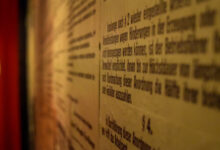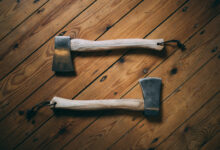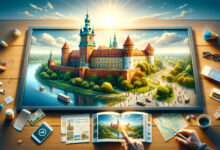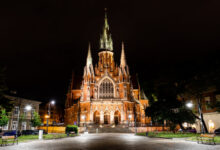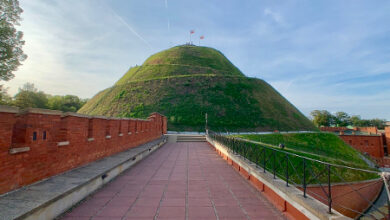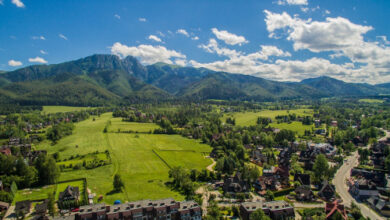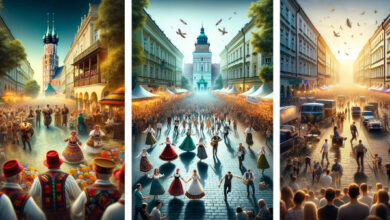Old Town in Krakow – what to visit
Experience the best of Krakow's Old Town: a guide to must-see attractions
Krakow is one of the oldest cities in Poland. It is most knows from history, culture, education, business and tourism. The beginnings of Krakow date back to the 7th century, which makes it one of the oldest cities in Poland. In Krakow there is located Wawel Castle – place of royal family power, archbishop cathedral and royal necropolis. Below are the most important monuments of Krakow – the Old Town.
Table of Contents:
1. Main Square
Is one of the most important places in Krakow. A meeting place for tourists and Krakow residents. It was here that many important meetings and events for the kingdom and the Polish state took place.
The market was created by the authorities in 1254. Nowadays is located in the Old Town in Krakow – the oldest part of city, where you can find the oldest monuments of Krakow.
The Main Square has a square shape with a side of 200 meters. The market is connected from the north with the Florian Gate. From this gate trough Square and to Royal Casthe there is so called – The Royal Route.
At the Market Square there is the St. Mary’s Church and the church of St. Wojciech. And also in the centre we can find the cloth hall and the town hall tower.
The market is one of the largest such facilities in Europe. The most important annual and one-off events take place there.
Like the Christmas and Easter markets, New Year’s concerts, the inauguration of juveniles, a crib competition, the Dragon Parade or the Lajkonik Parade.
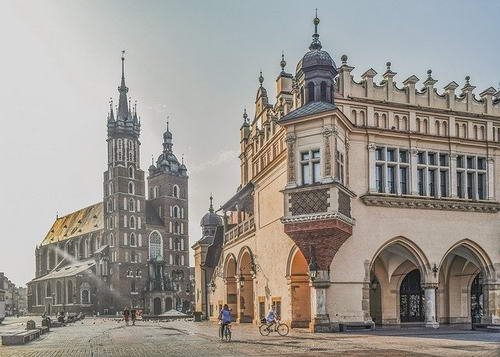
2. Statue of Adam Mickiewicz
Adam Mickiewicz was born in 1798. He is one of the most important Polish poets, publicists, translators and philosophers. He is one of the Three Bards / Seers – prophet poets who predict the future. His most important works are “Pan Tadeusz”, “Konrad Wallenrod”, “Ode to Youth” and “Crimean Sonnets”.
Thanks to his literary merits, Adam Mickiewicz was honored post mortem by building his monument in Krakow market square in 1898 – evenly on his 100th birthday. The monument was created according to the design of Teodor Rygier.
The monument has 10 meters high – Mickiewicz himself on the top and below four figures – allegories of homeland, bravery, science and poetry. In August 1940, the Germans destroyed the monument during the occupation.
Fortunately after the war, it was reconstructed from elements found at the German scrap yard in Hamburg. And again it was unveiled on the 100th anniversary of Mickiewicz’s death in 1955.

3. Saint Mary Church
Basilica of the Assumption of the Virgin Mary, called St. Mary’s Church in Krakow. It belongs to one of the most recognizable monuments in Poland.
This is a gothic church located in old town in Krakow. However, in the past it looked a bit different.
At the beginning of the existence of Krakow and at beginning of Polish Christianity, it was a wooden church built in 1221. In its place in 1320, an early Gothic church was erected. Which was changed and expanded every few decades. In 1443, most of the temple collapsed during the earthquake.
Then followed its next reconstruction and new architectural changes. In the 15th century, the church receives a beautiful wooden altar by Wit Stwosz in the form of a pentaptych.
The eighteenth century brings the interior of the church in late baroque style. In order for the interior to be converted into neo-Gothic in 1887. Fortunately, at the end of the 20th century, a comprehensive restoration of the church was made and its original splendour restored.
The church has two towers. The lower – 89 meters – serves as a belfry. And higher – Hejnalica – bugle call function. Because of this he believes every hour to the four corners of the world is played the most famous bugle call in Poland.

4. Słowackiego Theater
It was built in 1893. Located at the Holy Spirit Square. It bears the name of the Polish poet Juliusz Słowacki. It was created as representation of other European Baroque theatres.
The interior of the theatre is decorated with frescoes by the Viennese artist. This theatre is recognized as the birthplace of Polish acting, stage design and direction. Heater as one of the few in Poland was illuminated at the very beginning of its existence with electric light.
Because the theatre had its own power plant. Which today is open to the public and there is a small stage in which plays are also played. Premieres of outstanding writers took place here. “Wedding”, “Dziady”, “Kordian” and “Non-divine comedy”.
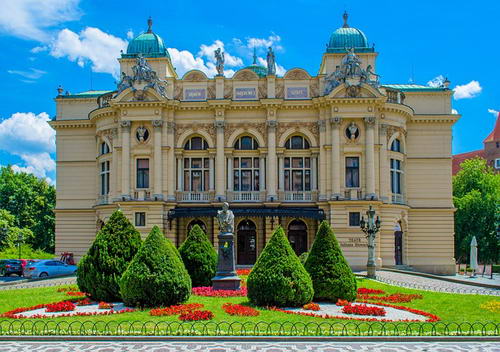
5. Florian’s Gate
In Old Town in Krakow at Floriańska Street there is a medieval gate with a tower. They were one of eight Krakow defensive gates in past. The Florian’s Gate is a remnant of the city’s defensive walls that surrounded the entire old city.
They were demolished – the remainder is a fragment along with the Florian Gate. The tower has a height of 34 meters, and is built of various architectural styles from Romanesque through Gothic to Baroque.
It took its name from Saint Florian who is her patron. On the tower’s front there is a bas-relief with Saint Florian.

6. Barbican
The Barbican is located in Planty park. Formerly it was connected to the city walls. It was the northernmost element of the fortifications of medieval Krakow. Its diameter is 24 meters, and the thickness of the walls is over 3 meters.
When the city was surrounded by walls, the Barbican was a place through which one could enter the city. It was connected to the Florian Gate by a bridge. The Barbican itself would be surrounded by a deep moat.
It was a very important defensive element of the city, built of brick with small defensive windows, it was ideal for maintaining defence during a siege. Currently, the Barbican building is part of the Historical Museum – there are shows of knights’ fights and medieval exhibitions.
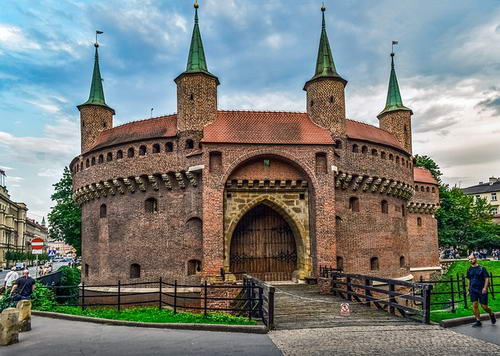
7. Cloth Hall – Sukiennice
The original Cloth Hall building was built of wood. However, due to fires in the 13th century, the Polish prince ordered modernization and erecting a stone building.
Two rows of stalls with a street among them. In the following centuries, the successors of Polish rulers rebuilt the Cloth Hall in the Gothic, Renaissance style up to the nineteenth century.
The current building is a monument that still has stalls. The National Museum is located on the first floor. In addition, the Cloth Hall hs the entrance to the Museum of the Underground Market in Krakow.
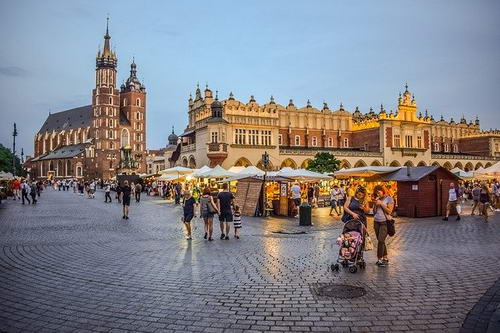
8. Planty
Planty is currently a city park surrounding the Old Town in Krakow. The park was created in 1822 after the city walls were demolished and the moat was buried.
The initiator of this idea was Feliks Radwański, because before the creation of the park this place was a dump and sever. The park was a place of meetings of residents.
During World War II, the park was degraded by the Germans. Who cut out most of the trees and plundered the fence separating the park from the road. The park is entrusted with 21 hectares.

9. Sant Anna Church
It is a baroque academic church of the Jagiellonian University. St. Anna’s collegiate church has undergone many stages and renovations since its foundation in the fourteenth century. Initially it was a wooden temple, later in the Gothic style up to the present Baroque form.
The church has a baroque 25-voice organ from 1723. They have an authentic sound from the period of Jan Sebastian Bach. In the underground there is a crypt – the burial place of professors of the Jagiellonian University.
10. Collegium Maius
It is the oldest building of the Jagiellonian University. The building was purchased by King Władysław Jagiełło in 1400 for University. On the Collegium ground floor there were lecture halls, and on the first floor a library with professors’ flats.
Until 1864, the building survived almost unchanged. However, from 1864 to 1940 the building became the seat of the Jagiellonian Library.
After the WW II, Collegium was restored to its previous form and it was the seat of the Jagiellonian University Museum.
The building is made of stone and brick. It has a lot of late Gothic elements. As Nicolaus Copernicus himself studied at the museum, you can see today the instruments used by the astronomer and one of the oldest globes.
11. Sant Wojciech Church
The church dates from the Xth century. Which puts him in the position of one of the oldest churches in Old Town in Krakow.
History says that on the market St. Wojciech was preaching, and exactly on this place was erected wooden temple. And Saint Wojciech was the patron of this temple.
The stone Romanesque building was erected in the 11th century. The building is covered with a baroque dome. And in the basements there is an exhibition related to the history of the church and the Market Square.
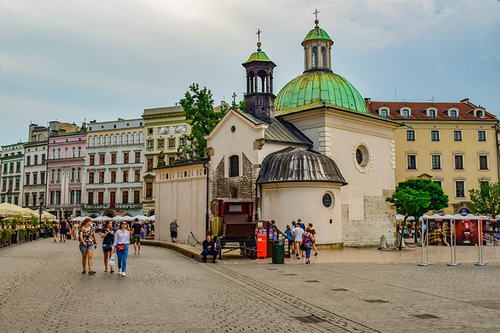
12. Tower of Town hall
The Gothic town hall tower dates from the 15th century. When she was part of the town hall. The town hall itself was destroyed in 1820, until that time it served as an administrative building.
Currently, the tower has the gothic form. It has clocks and a viewing terrace to which stairs lead. In the past, money, a treasure or an insignia of administrative power were stored in the room on the ground floor. However, the basement housed a Krakow prison. The height they built was 70 meters.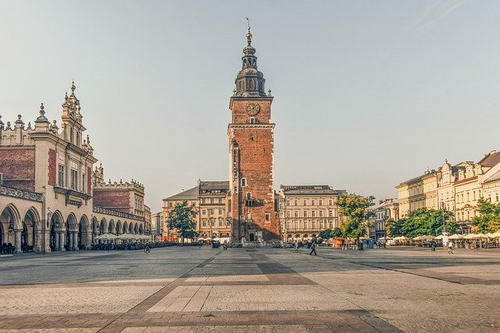
13. Church of Saint Peter and Paul
Undisputedly this is the first building in the barok style built entirely in Krakow. It was funded by King Zygmunt III Waza.
The church was consecrated in 1635. Initially, he served the University of Krakow. It has a very important function of religion – important Poles rest in its crypt. Such as Piotr Skarga, Andrzej Trzebicki, Sławomir Mrożek, Marian Rejewski, Jerzy Różycki, Zygmunt Wróblewski, Henryk Zygalski and Karol Olszewski.
An interesting fact is that the longest Foucault pendulum in Poland, 46 meters long, was hung in the church. Every Thursday there is a demonstration showing the Earth’s rotation.
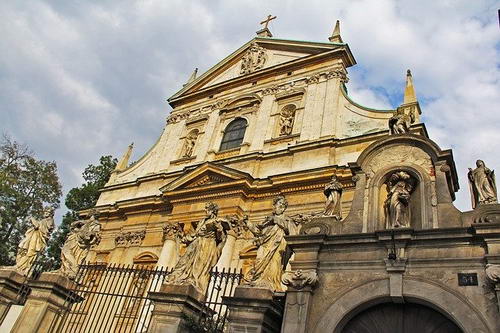
14. Wawel Castle
In the Middle Ages, Wawel was the centre of power of the Slavic tribe – the Vistulans. Who began their rule in this area in the 8th century.
Read also:
Old chronicles mention their legendary ruler king Krak – where the name of the city comes from. In 1000, a bishopric was created in Krakow, as a result of which a cathedral was built at Wawel – the seat of the bishop.
Wawel has been constantly transforming since the beginning of its existence due to invasions and the development of the Polish Kingdom.
King Kazimierz Odnowiciel moved the capital to Wawel in 1038. Wawel became the most important city in Poland – which caused its social and architectural changes. In 1978 Wawel was inscribed on the UNESCO heritage list, Wawel and other monuments of Krakow are particularly protected.
Wawel for many centuries served as the centre of power, hence the most important Polish kings and book are buried in the Wawel Arch-cathedral Basilica.

